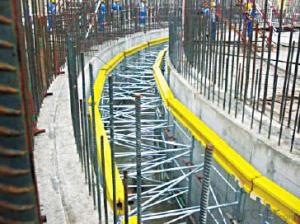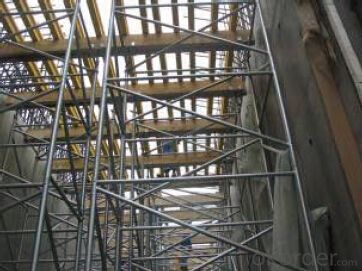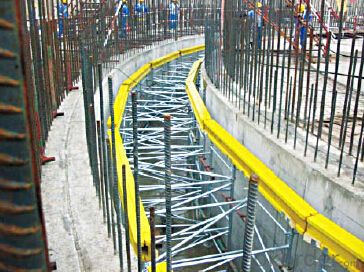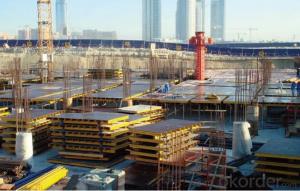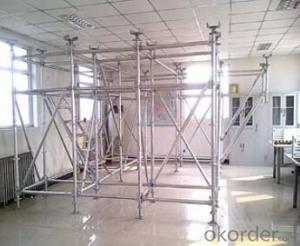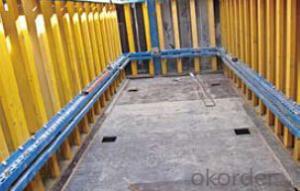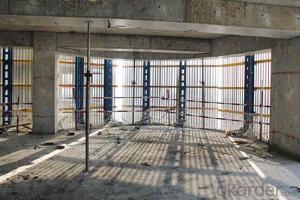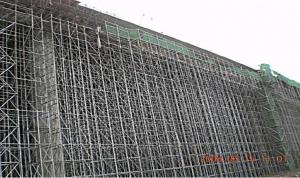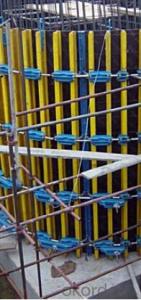Tower Scaffolding for Formwork and Scaffolding System
- Loading Port:
- Tianjin
- Payment Terms:
- TT OR LC
- Min Order Qty:
- 50 m²
- Supply Capability:
- 1000 m²/month
OKorder Service Pledge
Quality Product, Order Online Tracking, Timely Delivery
OKorder Financial Service
Credit Rating, Credit Services, Credit Purchasing
You Might Also Like
Tower Scaffolding
Shoring tower is an effective supporting system. It is easy to assemble and dismantlement, and
has excellent stability and bearing capacity. It has been widely used in the construction of industry
& residential buildings , bridges, tunnels and dam project, etc.
Characteristics:
◆ High degree of standardization.
◆ Easy storage and transportation
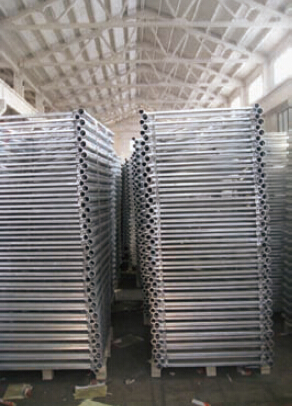
- Q:Can steel formwork be used for both small and large concrete pours?
- Yes, steel formwork can be used for both small and large concrete pours. Steel formwork is highly versatile and can be easily adjusted or modified to accommodate different sizes and shapes of concrete structures. It provides high strength and stability, making it suitable for large pours where heavy loads and pressures are involved. Additionally, steel formwork can be reused multiple times, making it a cost-effective option for both small and large construction projects.
- Q:Can steel formwork be used for both interior and exterior concrete finishes?
- Indeed, both interior and exterior concrete finishes can make use of steel formwork. Renowned for its robustness and longevity, steel formwork proves to be fitting for diverse purposes. Whether it pertains to interior partitions, pillars, or external pavement, steel formwork ensures a seamless and uniform foundation for concrete pouring. Moreover, steel formwork lends itself to effortless customization and adaptability, enabling it to meet project specifications with ease. This versatility renders steel formwork an excellent option for both interior and exterior concrete finishes.
- Q:Can steel formwork be used for elevated concrete slabs?
- Yes, steel formwork can be used for elevated concrete slabs. Steel formwork is known for its strength and durability, making it suitable for supporting the weight and pressure of concrete during construction. It provides a stable and rigid framework for pouring and shaping concrete, ensuring the formation of high-quality elevated slabs.
- Q:How does steel formwork affect the overall aesthetics of the structure?
- Steel formwork can have a significant impact on the overall aesthetics of a structure. Its sleek and smooth surface finish provides a clean and modern look, which is highly desired in contemporary architectural designs. The precision and accuracy of steel formwork also allows for intricate detailing and complex shapes to be achieved, enhancing the visual appeal of the structure. Furthermore, steel formwork enables the creation of sharp edges and crisp lines, resulting in a more refined and sophisticated appearance. This is particularly beneficial for structures with exposed concrete surfaces, as the use of steel formwork eliminates the need for additional surface treatments or finishing materials. Moreover, steel formwork offers versatility in terms of creating different textures and patterns on the concrete surface. By utilizing various surface treatments or coatings, such as acid etching or powder coating, architects and designers can further enhance the visual impact of the structure and create unique aesthetic effects. Additionally, steel formwork is known for its durability and structural integrity, ensuring that the aesthetics of the structure remains intact over time. Unlike other types of formwork, steel formwork does not warp or deform, providing a consistent and uniform appearance throughout the construction process and beyond. In summary, steel formwork positively influences the overall aesthetics of a structure by providing a sleek and modern finish, enabling intricate detailing and complex shapes, creating sharp edges and crisp lines, offering versatility in texture and pattern, and ensuring long-lasting durability.
- Q:Are there any specific considerations for using steel formwork in areas with high traffic loads?
- Yes, when using steel formwork in areas with high traffic loads, it is important to consider the strength and durability of the steel to ensure it can withstand the heavy loads. Additionally, proper reinforcement and support systems should be in place to distribute the weight evenly and prevent any deformation or structural failures. Regular inspections and maintenance are also crucial to identify and address any potential issues that may arise due to the high traffic loads.
- Q:How does steel formwork prevent concrete mixture separation during pouring?
- Steel formwork is used in construction projects to provide a temporary structure that holds the concrete in place until it sets and hardens. One of the key benefits of using steel formwork is that it prevents the concrete mixture from separating during the pouring process. The steel formwork is carefully designed and constructed to create a tight enclosure for the concrete, ensuring that it remains in its desired shape and consistency. It is made up of steel panels and frames that are securely fastened together to create a rigid structure. When the concrete mixture is poured into the steel formwork, it is held in place by the walls of the formwork itself. The steel panels and frames provide a smooth and even surface for the concrete to be poured onto, preventing any separation or segregation of the mixture. Furthermore, the steel formwork is designed with properly aligned joints and connections, which further helps in preventing any leakage or seepage of the concrete mixture. This ensures that the concrete remains intact and does not separate into its constituent materials such as aggregates, cement, and water. Additionally, the steel formwork is capable of withstanding the pressure exerted by the weight of the concrete. This prevents any deformation or movement of the formwork during the pouring process, which could potentially cause the concrete to separate or shift. Overall, the use of steel formwork provides a strong and stable structure that prevents the concrete mixture from separating during pouring. It ensures that the concrete remains in its desired form and consistency, resulting in a high-quality and durable finished product.
- Q:How does steel formwork handle concrete shrinkage cracking?
- Steel formwork handles concrete shrinkage cracking by providing a rigid structure that supports the concrete during the curing process. The steel formwork holds the concrete in place, preventing excessive movement and reducing the risk of shrinkage cracking. Additionally, the steel formwork helps to evenly distribute the forces generated during concrete shrinkage, minimizing the potential for cracking.
- Q:Can steel formwork be used for underground culverts?
- Yes, steel formwork can be used for underground culverts. Steel formwork is known for its durability, strength, and ability to withstand heavy loads and pressure. This makes it suitable for constructing underground culverts, which are designed to carry water, sewage, or other fluids below the ground surface. Steel formwork provides a rigid structure that can withstand the weight of the soil and any traffic loads above it, ensuring the stability and longevity of the culvert. Additionally, steel formwork is versatile and can be easily customized to accommodate different sizes and shapes of culverts. Overall, steel formwork is a reliable and efficient choice for constructing underground culverts.
- Q:How does steel formwork contribute to the accuracy of concrete placements?
- There are several ways in which steel formwork contributes to the accuracy of concrete placements. To begin with, the high level of dimensional accuracy associated with steel formwork ensures that the concrete structures being formed have the correct dimensions and shape. This is because the steel panels and components used in the formwork system are manufactured with precise measurements and tolerances. In addition, steel formwork provides excellent stability and rigidity, preventing any movement or deformation during the concrete pouring and curing process. This stability is crucial for maintaining the accuracy of the concrete placement, as any shifting or warping of the formwork can result in inconsistencies in the final product. Moreover, steel formwork is highly durable and capable of withstanding the pressure exerted by the fresh concrete. This durability ensures that the formwork remains intact and maintains its shape throughout the entire placement process. It also eliminates the risk of bulging or sagging, which can compromise the accuracy of the concrete placement. Furthermore, steel formwork allows for precise control of the concrete's surface finish. With steel formwork, it is easy to mold and shape the concrete to achieve the desired surface texture and quality. This is particularly important in architectural applications where aesthetics play a significant role. Lastly, steel formwork is reusable and can be easily assembled and disassembled, allowing for multiple uses. This reusability factor contributes to cost-effectiveness and ensures that the formwork remains in optimal condition for accurate concrete placements over time. In conclusion, the dimensional accuracy, stability, durability, surface finish control, and reusability of steel formwork make it an invaluable tool for achieving accurate and high-quality concrete placements.
- Q:Those who have these drawings, can send a copy to me, online, etc.
- The design of the steel formwork is 1.5 meters long or the length of 2 meters, so it can save the cost and improve the work efficiency
1. Manufacturer Overview |
|
|---|---|
| Location | |
| Year Established | |
| Annual Output Value | |
| Main Markets | |
| Company Certifications | |
2. Manufacturer Certificates |
|
|---|---|
| a) Certification Name | |
| Range | |
| Reference | |
| Validity Period | |
3. Manufacturer Capability |
|
|---|---|
| a)Trade Capacity | |
| Nearest Port | |
| Export Percentage | |
| No.of Employees in Trade Department | |
| Language Spoken: | |
| b)Factory Information | |
| Factory Size: | |
| No. of Production Lines | |
| Contract Manufacturing | |
| Product Price Range | |
Send your message to us
Tower Scaffolding for Formwork and Scaffolding System
- Loading Port:
- Tianjin
- Payment Terms:
- TT OR LC
- Min Order Qty:
- 50 m²
- Supply Capability:
- 1000 m²/month
OKorder Service Pledge
Quality Product, Order Online Tracking, Timely Delivery
OKorder Financial Service
Credit Rating, Credit Services, Credit Purchasing
Similar products
Hot products
Hot Searches
Related keywords

